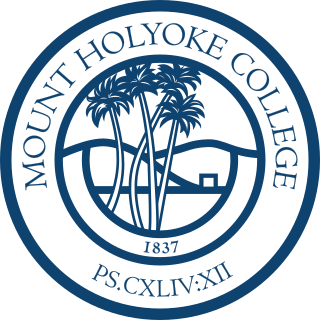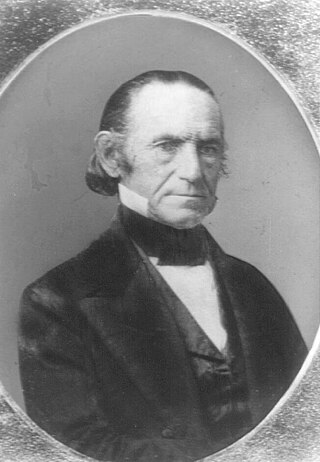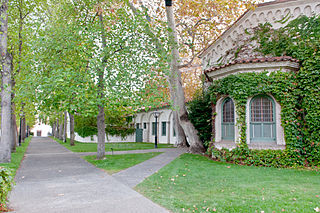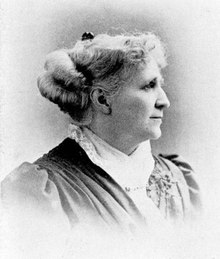
Mount Holyoke College is a private liberal arts women's college in South Hadley, Massachusetts, United States. It is the oldest member of the historic Seven Sisters colleges, a group of historically female colleges in the Northeastern United States. The college was founded in 1837 as the Mount Holyoke Female Seminary by Mary Lyon, a pioneer in education for women. Mount Holyoke is part of the Five College Consortium in Western Massachusetts.

Wellesley College is a private women's liberal arts college in Wellesley, Massachusetts. Founded in 1870 by Henry and Pauline Durant as a female seminary, it is a member of the Seven Sisters Colleges, an unofficial grouping of current and former women's colleges in the northeastern United States.
The Seven Sisters are a group of seven private liberal arts colleges in the Northeastern United States that are historically women's colleges. Barnard College, Bryn Mawr College, Mount Holyoke College, Smith College, and Wellesley College are still women's colleges. Vassar College became coeducational in 1969 and Radcliffe College was absorbed in 1999 by Harvard College and now offers programs in advanced study.

Mary Mason Lyon was an American pioneer in women's education. She established the Wheaton Female Seminary in Norton, Massachusetts, in 1834. She then established Mount Holyoke Female Seminary in South Hadley, Massachusetts, in 1837 and served as its first president for 12 years. Lyon's vision fused intellectual challenge and moral purpose. She valued socioeconomic diversity and endeavored to make the seminary affordable for students of modest means.
Knox College is a private liberal arts college in Galesburg, Illinois. It was founded in 1837 and offers more than 60 courses of study.

Princeton Theological Seminary (PTSem), officially The Theological Seminary of the Presbyterian Church, is a private school of theology in Princeton, New Jersey. Founded in 1812 under the auspices of Archibald Alexander, the General Assembly of the Presbyterian Church (USA), and the College of New Jersey, it is the second-oldest seminary in the United States. It is also the largest of ten seminaries associated with the Presbyterian Church.

Mary Emma Woolley was an American educator, peace activist and women's suffrage supporter. She was the first female student to attend Brown University and served as the 10th President of Mount Holyoke College from 1900 to 1937.

Alice Freeman Palmer was an American educator. As Alice Freeman, she was president of Wellesley College from 1881 to 1887, when she left to marry the Harvard professor George Herbert Palmer. From 1892 to 1895 she was dean of women at the newly founded University of Chicago.
The Mount Vernon Seminary and College was a private women's college in Washington, D.C. It was purchased by George Washington University in 1999, and became the Mount Vernon Campus of The George Washington University.

George Washington Gale was a Presbyterian minister who founded the Oneida Institute of Science and Industry. He later purchased land in Illinois that became Galesburg, Illinois, named in his honor, and was instrumental in founding Knox College.
Ismat Taha Kittani was an Iraqi politician, most notable for being President of the United Nations General Assembly during its thirty-sixth session in 1981 and 1982.

Women's colleges in the United States are private single-sex U.S. institutions of higher education that only admit female students. They are often liberal arts colleges. There are approximately 26 active women's colleges in the United States in 2024, down from a peak of 281 such colleges in the 1960s.

Barnabas Root, born Fahma Yahny, was the grandson of an American-born slave who had moved to Africa through the efforts of the American Colonization Society. Yahny attended the original Mendi Mission school in Mendiland, Sierra Leone, where he was educated by Mary McIntosh, an alumna of Knox College, in Galesburg, Illinois, which was founded in the Calvinist tradition. The College and many of the Congregational churches of the city were active with the American Missionary Association.

The Sophia Astley Kirkpatrick Memorial Chapel, known as Kirkpatrick Chapel, is the chapel to Rutgers, The State University of New Jersey and located on the university's main campus in New Brunswick, New Jersey in the United States. Kirkpatrick Chapel is among the university's oldest extant buildings, and one of six buildings located on a historic section of the university's College Avenue Campus in New Brunswick known as the Queens Campus. Built in 1872 when Rutgers was a small, private liberal arts college, the chapel was designed by architect Henry Janeway Hardenbergh at the beginning of his career. Hardenbergh, a native of New Brunswick, was the great-great-grandson of Rutgers' first president, the Rev. Jacob Rutsen Hardenbergh. It was the third of three projects that Hardenbergh designed for the college.

Susan Richardson, also known as Aunt Susan and Susan Van Allen, was an enslaved person who escaped and later helped to found Allen Chapel AME in Galesburg, a town that was a known safe haven on the Underground Railroad. Her escape prompted the 1844 Illinois Supreme Court case Borders v. Hayes. Richardson helped escaped slaves on the underground railroad while she lived in Galesburg.

Joseph Humphries Barquet was a Union soldier in the 54th Massachusetts Infantry Regiment and a civil rights activist. Born in a wealthy family in Charleston of mixed European and African descent, he lived most of his life in Illinois as a mason. He gave many speeches and wrote newspaper articles in support of various causes which were important to the Black communities of Galesburg, Illinois as a whole, and the U.S. military.

Ella Park Lawrence was an avid advocate for, and is still known today as the “mother” of the Illinois State Flag. She was the Regent of the Rebecca Park chapter of the Daughters of the American Revolution (DAR), State Regent of the DAR organizations in Illinois, as well as a known leader and philanthropist of her community, Galesburg, Illinois.
Fannie R. Givens was an artist, missionary, and political activist. Mainly a resident of Louisville, Kentucky, she created and taught art in many forms including painting and poetry and served as a policewoman for the city. Hicks was politically active in many different organizations, traveling around the world to advocate for Black and women's rights.
Mikiso “Miki” Hane was a Japanese American professor of history at Knox College, where he taught for over 40 years. He wrote and translated over a dozen books, wrote many articles, and was appointed a member of the National Council on the Humanities in 1991. He was born in California, lived in Japan during his teenage years, and was interned in Arizona during World War II. He taught soldiers Japanese at Yale, then studied there, where he attained a bachelors in 1952, a masters in 1953, and doctorate degree in 1957. He studied in Japan and Germany, then taught at the University of Toledo and studied in India before coming to Knox College in 1961. He lived in Galesburg for the rest of his life, and both wrote and taught up until his death.














